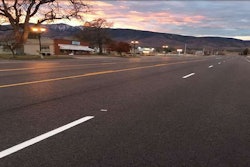 Side view shows transition zone concrete elements under the asphalt. Photo courtesy of TU Wien.
Side view shows transition zone concrete elements under the asphalt. Photo courtesy of TU Wien.Expansion joints are an important part of bridges that prevent the pavement from cracking when it expands in hot weather and contracts in cold weather, but they require a lot of maintenance. However, Daily Commercial News reports that researchers at the Vienna University of Technology (TU Wien) have developed a system that features a transition zone a few meters long at each end of a bridge, rather than a traditional expansion joint.
The system was patented and built on an Austrian autobahn, where it just went through its first winter in service and passed with flying colors.
Johann Kollegger headed up the team at TU Wien’s Institute of Structural Engineering that designed the transition zones, which don’t just absorb deformations in the bridge deck at each end of the bridge, but distribute them across a larger area. The system uses 20 to 30 concrete elements in a row that are connected by cables made from a special glass fiber material.
The resulting structure performs like a chain of beads threaded on an elastic cord, where if you pull on the cord, the distance between the beads increases evenly. So, when cold weather causes the bridge deck to contract, the concrete elements in the transition zones are pulled farther apart. Then in spring, the deck heats up and the distance between each of the concrete elements compresses.
Kollegger told the news agency that it was crucial to have a suitable asphalt mix to cover the concrete elements that was flexible enough to withstand the movements of the transition zones without cracking. So, he brought in a team headed by Ronald Blab from the university’s Institute of Transportation and worked with ASFiNAG, a publicly owned corporation that plans, finances, builds, maintains and collects tolls for the Austrian autobahn system, to construct and test the transition zones on the 112-meter-long Satzengrben Bridge. The group also installed comprehensive monitoring on the bridge and transition zones to record data during the winter, which showed positive results.
Michael Kleiser, a bridge construction expert at ASFiNAG, told the news agency that field measurements confirmed the design team’s theoretical calculations about the distribution of deformations across the individual concrete elements, and that the new technology could now be used on more bridges.











